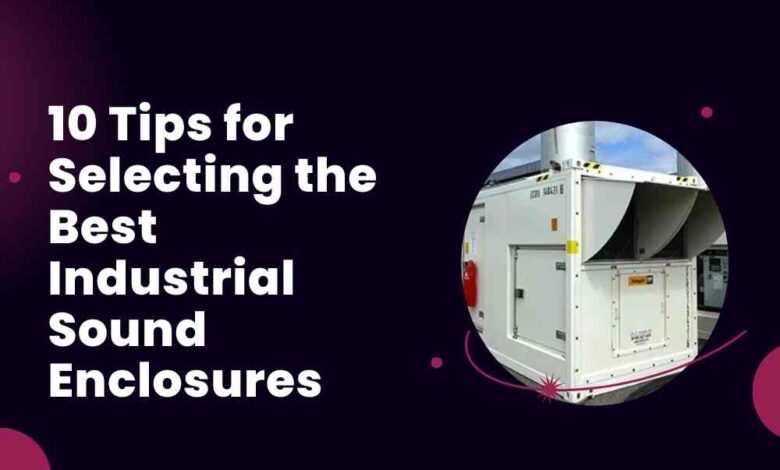10 Tips for Selecting the Best Industrial Sound Enclosures

Industrial sound enclosures are essential for managing noise in various industrial settings. They help create a safer and more comfortable environment for workers while ensuring compliance with noise regulations. Selecting the best sound enclosure requires careful consideration of several factors. Here are ten tips to guide you in choosing the right industrial sound enclosure.
Understanding the Importance of Industrial Sound Enclosures
Industrial sound enclosures are designed to control and reduce noise levels in factories, plants, and other industrial sites. These enclosures can significantly lower noise pollution, which can lead to improved worker health, safety, and productivity. High noise levels can cause hearing loss, stress, and decreased concentration among employees. By investing in quality sound enclosures, you can create a quieter and more efficient workspace. Additionally, reducing noise pollution can help your company comply with local and international noise regulations, avoiding potential fines and legal issues.
ADDITIONALLY : “Ready to enhance your workplace with top-notch noise control? Discover the difference with our industrial sound enclosures! Click here to learn more and get a free consultation today!”
Assess Your Noise Control Needs
Before selecting an industrial sound enclosure, it is crucial to assess your specific noise control needs. Identify the sources of noise within your facility and determine the noise levels they produce. Consider the type of machinery or equipment generating the noise and the areas most affected. This assessment will help you understand the level of noise reduction required and the best type of enclosure for your situation. Consulting with a noise control specialist can provide valuable insights and recommendations tailored to your needs.
Consider the Enclosure Material
The material of the sound enclosure plays a significant role in its effectiveness. Different materials have varying sound-absorbing and sound-blocking properties. Common materials used for industrial sound enclosures include steel, aluminum, and various types of acoustic panels. Steel enclosures are durable and provide excellent sound reduction, but they can be heavy and more challenging to install. Aluminum enclosures are lighter and easier to handle but may not offer the same level of noise reduction as steel. Acoustic panels can be customized for specific noise frequencies, providing targeted noise control. Choose a material that meets your noise reduction needs and fits within your budget and installation constraints.
Evaluate the Design and Construction
The design and construction of the sound enclosure are critical to its performance. Look for enclosures with a robust and airtight design to prevent noise leakage. The enclosure should have minimal gaps and seams, as these can significantly reduce its effectiveness. Additionally, consider the ease of access for maintenance and operation of the enclosed equipment. Some enclosures feature removable panels or doors, making it easier to perform routine maintenance without dismantling the entire structure. A well-designed enclosure will provide efficient noise reduction while allowing for easy access and operation.
Ensure Proper Ventilation and Cooling
Proper ventilation and cooling are essential for maintaining the performance and longevity of both the sound enclosure and the enclosed equipment. High temperatures can damage machinery and reduce the effectiveness of the enclosure’s sound-absorbing materials. Look for enclosures with built-in ventilation systems, such as fans or louvers, to ensure adequate airflow. Some enclosures also feature noise-reducing ventilation solutions that allow for proper cooling without compromising noise control. Ensure that the ventilation system is appropriately sized for your equipment’s needs to prevent overheating and maintain optimal performance.

Customization and Flexibility
Every industrial setting has unique noise control requirements, so it’s essential to choose an enclosure that can be customized to your specific needs. Look for manufacturers that offer customization options, such as different sizes, shapes, and materials. Some companies can also provide modular enclosures that can be easily expanded or reconfigured as your needs change. Customizable enclosures ensure that you get the most effective noise control solution tailored to your specific requirements, providing better performance and value for your investment.
Compliance with Noise Regulations
Compliance with noise regulations is a critical factor when selecting an industrial sound enclosure. Different countries and regions have specific noise standards that must be met to avoid fines and legal issues. Ensure that the enclosure you choose meets or exceeds the relevant noise regulations for your industry and location. Working with a reputable manufacturer that understands these regulations can help you select an enclosure that ensures compliance and provides effective noise control.
Consider Installation and Maintenance
The installation and maintenance of the sound enclosure are important considerations for ensuring long-term performance. Choose an enclosure that is easy to install, preferably with clear instructions and minimal disruption to your operations. Some manufacturers offer installation services, which can save time and ensure the enclosure is set up correctly. Additionally, consider the ease of maintenance and repair. Enclosures with removable panels or modular designs can make it easier to perform routine maintenance and repairs, reducing downtime and ensuring the longevity of the enclosure and the enclosed equipment.
Cost and Budget Considerations
Cost is always a crucial factor when making any industrial investment. While it’s essential to find a cost-effective solution, it’s equally important not to compromise on quality and performance. Cheaper enclosures may save money upfront but can result in higher costs in the long run due to lower noise reduction performance, increased maintenance, and potential non-compliance with noise regulations. Consider the total cost of ownership, including installation, maintenance, and potential fines for non-compliance. Investing in a high-quality sound enclosure can provide better long-term value and performance, ensuring a quieter and more efficient workspace.
Seek Expert Advice and Recommendations
Selecting the best industrial sound enclosure can be a complex process, especially with the numerous options and factors to consider. Seeking expert advice and recommendations can provide valuable insights and help you make an informed decision. Consult with noise control specialists, acoustic engineers, or reputable manufacturers with experience in industrial noise control. They can assess your specific needs, recommend suitable enclosures, and provide guidance on installation, maintenance, and compliance with noise regulations. Working with experts ensures that you choose the most effective and reliable noise control solution for your industrial setting.
Conclusion: Making the Right Choice for Your Industrial Sound Enclosure
Selecting the best industrial sound enclosure requires careful consideration of various factors, including your specific noise control needs, enclosure material, design, ventilation, and compliance with regulations. By following these ten tips, you can make an informed decision that ensures effective noise reduction, improved worker safety and productivity, and compliance with noise standards. Investing in a high-quality sound enclosure tailored to your needs can provide long-term benefits and a quieter, more efficient industrial environment. Seek expert advice, evaluate your options, and choose a solution that offers the best performance and value for your investment.
For more insightful articles related to this topic, feel free to visit usafulnews



